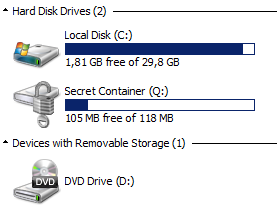Virtual Bitlocker Containers
This week, I got an interesting question from a customer: "What do you recommend to safely store files in a directory on my laptop?". They are plenty of ways to achieve this, the right choice depending on the encryption reliability, the ease of use and maybe some technical requirements. Sometimes, a simple encrypted zip file will do the job, sometimes something stronger is mandatory. In Microsoft environments, Bitlocker is a nice solution since Windows 7. But it was not the right choice for my customer, he did not want to use Bitlocker in its "FDE" ("Full Disk Encryption") way. For years, I'm a big fan of TrueCrypt which is able to work with partitions but also with containers. When not used, those are seen just as big binary files for the operating system. Since the bad story that happened to TrueCrypt, I switched to GostCrypt, a 100% compatible alternative developed by a group of universities.
If your environment is fully running on top of Windows OS, why not use Bitlocker after all? If it's not possible to encrypt a single directory (as requested by my customer), why not create a container "in the TrueCrypt way"? Do you know that Windows is able to create virtual disk and mount them like a "mount -o loop" on Linux? This operation is achieved with diskpart, a command line tool available in C:\Windows\System32.
Start a command prompt, launch "diskpart" and a new command line window will open: (Note: you will be playing with the file system, so administrator's privileges are required!)

Let's go! First we must create a virtual disk of the size you need, the size being in MB: (Keep in mind that Bitlocker requires a minimum disk size to be enabled)
DISKPART> create vdisk file="c:\container.vhd" maximum=120 type=fixed 100 percent completed DiskPart successfully created the virtual disk file.
Now, the next steps are to select the virtual disk, create a single partition and format it in NTFS:
DISKPART> select vdisk file="c:\container.vhd" DiskPart successfully selected the virtual disk file. DISKPART> attach vdisk 100 percent completed DiskPart successfully attached the virtual disk file. DISKPART> list vdisk VDisk ### Disk ### State Type File --------- -------- -------------------- --------- ---- * VDisk 0 Disk 1 Attached not open Fixed c:\container.vhd DISKPART> list partition There are no partitions on this disk to show. DISKPART> create partition primary DiskPart succeeded in creating the specified partition. DISKPART> list partition Partition ### Type Size Offset ------------- ---------------- ------- ------- * Partition 1 Primary 18 MB 64 KB DISKPART> select partition 1 Partition 1 is now the selected partition. DISKPART> format fs=ntfs label="Secret Container" 100 percent completed DiskPart successfully formatted the volume. DISKPART> active DiskPart marked the current partition as active. DISKPART> assign letter=q DiskPart successfully assigned the drive letter or mount point. DISKPART> exit
You should now see a new disk connected:

The next step is to enable Bitlocker on the container and configure it like a normal disk. Right click on the new drive and configure Bitlocker as usual.
Once completed, the disk looks like a normal Bitlocker container:

To unmount the container, use the "detach vdisk" command in diskpart.
To make the container available after a reboot, the operation to mount the vdisk can be automated via a simple script:
select vdisk file="c:\container.vhd" select partition 1 attach vdisk
You can execute this script via the following command. Once mounted, the classic Bitlocker pop-up windows will ask you the password to unlock the container.
C:\> diskpart /s bitlocker.txt
With this method, you can easily exchange Bitlocker containers with peers, you can create multiple containers for multiple projects and you can create containers on USB disks without having to reserve the entire space for this purpose!
Xavier Mertens
ISC Handler - Freelance Security Consultant
PGP Key


Comments